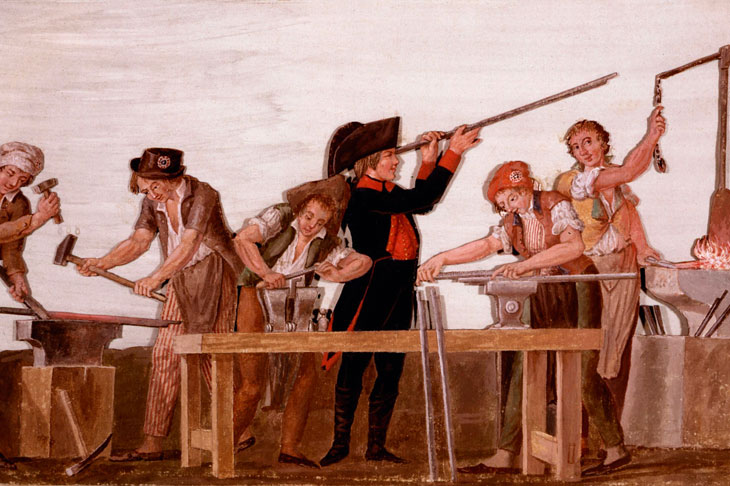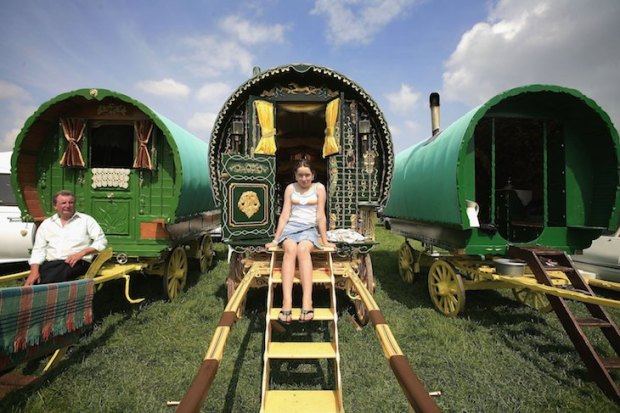Arguably, the statue in Trafalgar Square should not be of Nelson but of Henry Maudslay. He had started out as a 12-year-old powder monkey, fetching gunpowder on Navy ships, but soon revealed himself to be a brilliant engineer. In the early 1800s, Maudslay built ‘the first precision-made machines in the world’. They produced pulley blocks, ‘the essential parts of a sailing ship’s rigging’, which allowed the Royal Navy to ‘travel, police, and, for a while, rule the world’s oceans’, writes Simon Winchester. The machines outfitted the ships that defeated Maudslay’s hero, Napoleon. Most of Maudslay’s superb devices in Portsmouth docks were ‘still working a century and a half later; the Royal Navy made its last pulley blocks in 1965,’ notes Winchester.
Machines shape human history. But they get little attention, in part because few writers understand them. Winchester, a veteran craftsman of readable non-fiction, has written a flawed book about a crucial subject: the birth, rise and possible end of precision technology.
His father, a precision engineer, would sometimes bring home pieces of machines from one of his factories and (to his wife’s chagrin) show them to his son on the dinner table. A fascination was born — then reignited by an email from a stranger in Florida in 2011: ‘Why not write a book on the history of precision?’
The first person who ever tried to produce a precision instrument was probably an unknown Greek artisan in the second century BC. Around 1900, Greek fishermen diving for sponges found ‘a telephone directory-size lump of corroded and calcified bronze and wood’. The lump was ignored for decades, but in 2006 a paper in Nature identified it as a mechanical device that calculated (with fantastic inaccuracy) lunar phases and planetary movements.
Winchester identifies the ‘father of true precision’ as the 18th-century Cumbrian, John Wilkinson. His father, a Lakeland shepherd, had discovered ore and coal on his pastures and become an iron-master. Wilkinson created an iron-boring tool capable of making an identically sized hole in every cannon. Firing accuracy improved massively.
In May 1776, Wilkinson began using the same technique to make inch-perfect cylinders for his friend James Watt’s steam engines. Instantly, these stopped leaking steam. Mass-produced precision had elbowed aside individual artisans and kickstarted the Industrial Revolution. The United States — which gained independence two months after Wilkinson’s breakthrough — would become a superpower thanks largely to precision manufacturing.
Machines kept getting more precise. For a long time, many of the forgotten geniuses who invented them were British. In 1929, the 22-year-old RAF pilot Frank Whittle hit upon the idea of using a gas turbine as a plane engine. The German Hans von Ohain had the same insight four years later, but the Nazi government decided not to fund it. The first British jet engine — so called because it expelled a jet of air from its rear — flew in 1941. When Whittle won a postwar prize of half a million dollars, he chose to share it with Von Ohain.
But by then, the advance in precision was becoming an American story. Henry Ford, inspired by watching the dismembering of pig carcasses in an abattoir, pioneered the assembly line. His machines made precisely interchangeable car parts, because if any part didn’t fit the whole line would be halted. Soon his Dearborn factory was producing a Model T every 40 seconds.
More recently, precision has been driven by what Winchester calls ‘the dark side’: the American military. For instance, the satellite-based Global Positioning System, or GPS, started out as a top secret military tool in 1978.
Gradually, the demands of precision have grown beyond the capacities of any mere human. We can now only mess things up. In November 2010, a Qantas Airways plane that had just taken off in Singapore caught fire in mid-air and began falling apart. Three years later, an official report identified the culprit: an unnamed engineer at a Rolls-Royce plant in the Midlands in 2006,who had bored a fractionally untrue hole into a two-inch metal pipe. When metal fatigue set in, the pipe ruptured. Happily, the Qantas plane landed safely.
In fact, modern precision technologies can now usually save us from human error. In 2017, for the first time ever, the world’s airlines recorded no deaths from accidents on commercial passenger jets. This smoothness rather spoils some of Winchester’s attempts to build narrative. Halfway through a long, unstructured story about a faulty mirror in the Hubble Space Telescope, we find out that the thing was repaired in space in 1993. The Hubble is expected to keep flying at least.
By then, precision might have been reaching its limits. Moore’s Law — which predicted correctly in 1965 that computing power would double every year — may eventually have to be retired. Today’s computer chips contain ‘seven billion transistors on one circuit, 100 million transistors’ in a square milli-metre, writes Winchester. The space between transistors now ‘approaches the diameter of individual atoms’. Once you get to subatomic levels, as Werner Heisenberg suggested nearly a century ago, ‘matter comes packaged as either waves or particles that are by themselves both indistinguishable and immeasurable’. Bang goes precision.
Winchester asks whether this might actually be a good thing. How desirable is precision? That’s an interesting question, but he barely pursues it, branching off instead into an urbane travelogue about Japanese watch craftsmen.
Given the author’s journalistic flair, Exactly is a disappointing book. In part, the problem is capturing machine processes in words. Winchester’s sub-Dickensian attempts rarely succeed. The other problem is imprecise prose: he rarely uses one word where four will do. One day there’ll be a machine that does better.
Got something to add? Join the discussion and comment below.
Get 10 issues for just $10
Subscribe to The Spectator Australia today for the next 10 magazine issues, plus full online access, for just $10.
You might disagree with half of it, but you’ll enjoy reading all of it. Try your first month for free, then just $2 a week for the remainder of your first year.















Comments
Don't miss out
Join the conversation with other Spectator Australia readers. Subscribe to leave a comment.
SUBSCRIBEAlready a subscriber? Log in